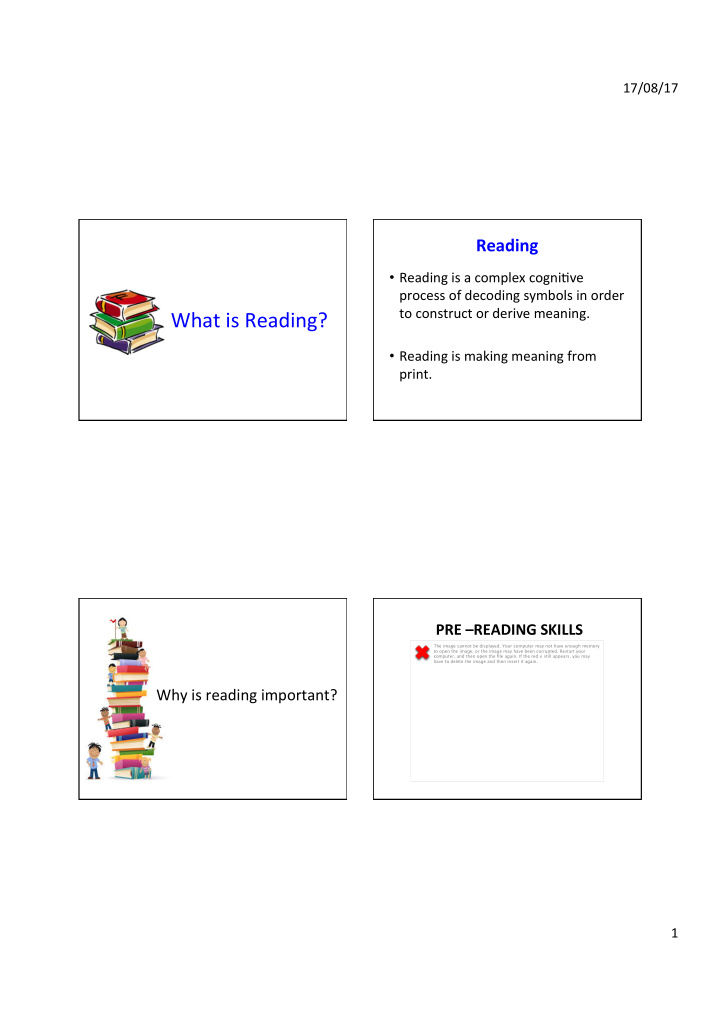



17/08/17 Reading • Reading is a complex cogni9ve process of decoding symbols in order to construct or derive meaning. What is Reading? • Reading is making meaning from print. PRE –READING SKILLS The image cannot be displayed. Your computer may not have enough memory to open the image, or the image may have been corrupted. Restart your computer, and then open the file again. If the red x still appears, you may have to delete the image and then insert it again. Why is reading important? 1
17/08/17 PHONICS Pre Reading Skills • It teaches the connec9on between leJers Phonemic Awareness and sounds • is the awareness of the sounds of language • It involves blending and segmen9ng Ø words in a sentence • Is the awareness that oral language can be Ø compound words broken into components-sentences, words, Ø syllables syllable, onset-rime and phonemes Ø ending sound-beginning sound Ø Vowel sounds • It provides strategies for decoding Alphabe9c Principle 1 Alphabe9c principle of English language • The leJers in alphabet represent Sounds. Vowel Sounds • LeJers and combina9ons of leJers represent speech sounds. • This is based on systema9c and predictable a as in the first sound of apple rules. e as in the first sound of elephant i as in the first sound of igloo o as in the first sound of orange u as in the first sound of umbrella 2
17/08/17 Consonants & Vowel Sounds Alphabe9c Principle 2 Alphabe9c Principle 3 • Some9mes more than one leJer makes a • Some sounds can be wriJen in more than one sound. way – Spelling Alterna9ve. sh as in shop ai(rain) eight (eight) ay (play) igh as in light ow (know) oa (boat) oe (toe) ph as in phone th as in thin eigh as eight 3
17/08/17 Alphabe9c Principle 3 Alphabe9c Principle 4 • Some sounds can be wriJen in more than one • Overlap - Same symbol can represent more way – Spelling Alterna9ve. than one sound. ai(rain) eight (eight) ay (play) train -------- ai ---------- said ow (know) oa (boat) oe (toe) head -------- ea --------- beach Decoding • It is the process of applying word aJack strategies to figure out unknown words Strategies to help: v recognising sight words through flash cards v using analogy or another known word v using the context v chunking units v blending v pseudo word reading 4
17/08/17 Decoding Units Decoding unit ‘ight’ 12. et 13. id, i 14. ig, im The bird was ready to put up a fight, so he bet bid big bent slightly to the right. That was an get did dig oversight because he slipped and fell from a jet hid fig great height. Like a bolt of lightening the let kid pig met lid rig knight rode quickly up to the tree to save the net rid nightingale, who was so light. Sadly, the bird pet dim had landed on his head and that certainly set if him vet in rim was not a preJy sight. wet it yet is What are sight words? Why Are They Important? • First 100 of these most frequently used words make 50% of our wriJen material • Sight words are words that are recognized automa9cally (within three seconds) while • Instant recogni9on of these commonly used reading words makes reading faster • They are read without using decoding skills • Pausing and decoding each word leads to memory overload and fa9gue • They are some9mes also referred to as high frequency words • Consequently understanding of what is read suffers 5
17/08/17 Stage-3 Building Fluency Reading pracNce- More prac9ce won’t help but guiding how to read will help Reading Approaches: o Model fluent reading- phrasal reading o Alternate Reading o Neurological Impress o Choral Reading- whisper reading o Echo reading o Peer Reading/ buddy reading o whole word reading- reading content of interest, students’ own stories wriJen by you o Reading Apps/ taped reading Strategies for fluent reading • Look for Decoding Units or leJer string – ag/ ick • Looks for chunks you know ( and in stand / fin in finger) • Look vowel paJerns – ee, ea, aw • Spot the silent leJers • Look for prefix and suffix- re,un ing, s,es, 9on • Solve one piece at a 9me – different • Skip over the word and come back to it • Now reread 6
17/08/17 Interven9ons Attention : Provide passages of interest at the child’s comfort • level. Use window /pointer to help focusing. Colour code full stops, • word endings Memory: Use letter chart. • Remind with cues and associations. • Repetitions/drill in fun ways • Memory games [auditory and visual] 1 exercise everyday • Teach chunking • Brain gym: Both sides of our body need to be coordinated and • integrated. This includes our eyes and ears Visual and Auditory discrimination: t/th sounds • b/d, u/n; dominoes, card games,sorting, puzzles Research shows that 80% of difficulty is due to phonemic discrimination and STM 7
Recommend
More recommend